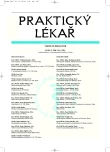Recommended diagnostic steps for general practitioners attending patients with difficulties that could indicate multiple myeloma
Authors:
Z. Adam 1; J. Bednařík 2; J. Neunauer 3; R. Chaloupka 4; J. Vorlíček 1; J. Vaníček 5; L. Pour 1; Z. Čermáková 11; Weinreb M. Za Českou Myelomovou Skupinu: Ščudla V. 12 6; V. Maisnar 7; J. Straub 8; M. Schutzova 9; E. Gregora 10
Authors‘ workplace:
Interní hematoonkologická klinika FN, Brno Bohunice
1; Neurologická klinika FN, Brno Bohunice
2; Radiodiagnostická klinika FN, Brno Bohunice
3; Ortopedická klinika FN, Brno Bohunice
4; Klinika zobrazovacích metod FN U sv. Anny Pekařská, Brno
5; III. interní klinika FN, Olomouc
6; II. Interní klinika - OKH FN, Hradec Králové
7; I. Interní klinika - hematoonkologická Všeobecná fakultní nemocnice, Praha
8; Hematologicko-onkologické oddělení FN, Plzeň
9; Oddělení klinické hematologie FN Královské Vinohrady, Praha
10; Oddělení klinické biochemie FN, Brno Bohunice
11; Dětská onkologická klinika FN, Brno
12
Published in:
Prakt. Lék. 2006; 86(7): 396-410
Category:
Diagnostis
Overview
Multiple myeloma incidence in the Czech Republic is 3 to 4 cases per 100 000 inhabitants. Incidence increases in the older age groups. Multiple myeloma responds well to treatment, and disease remission persisting for years is common. Following treatment some patients return to full employment. Early diagnosis is paramount for successful treatment and it depends in many cases on the first contact doctors. Therefore, in cooperation with neurologists, orthopaedists and radiologists, the Czech Myeloma Group has issued the following brief guidelines, followed by detailed text, describing the symptoms and diagnostic pitfalls of the disease for the first contact doctors. This disease has the characteristics of a chameleon with respect to the variety of symptoms. For ease we will summarize multiple myeloma symptoms into 5 subparagraphs. Each of them is a reason for examination with the aim of confirming or not confirming (NOTE: not to rule out) the malignant origin of the problem. If one of these recommended examinations is positive, it is a reason for continuing the diagnostic process. A general practitioner usually refers the patient to the specialised department for this follow-up examination. Observance of these guidelines should minimize the number of belatedly diagnosed cases.
1. Symptoms of bone destruction
• Unexplained pain of some of the spinal segments persisting for more than one month even without signs of radicular irritation or pain in other skeletal parts (ribs, hips or long bones). Pains caused by incipient multiple myeloma are similar to the pain in patients with common vertebrogenous problems of nonmalignant origin. The intensity of common vertebrogenous problems diminishes very often by one month, whereas the intensity of bone pain caused by malignant disease increases continually.
• Rest and night backache or pain of other skeletal parts is indication for immediate radiographic examination and eventually for other imaging and laboratory examinations.
• Backache with signs of spinal cord or radicular compression is an indication for urgent referral to a specialised department where X-ray and targeted CT/MRI examinations can be carried out and if necessary, the appropriate urgent operation can be performed.
• Osteoporosis, especially in men and premenopausal women
2 Symptoms of compromised immunity and/or impaired bone marrow function
Recurrent or persistent infections, anaemia, typically normochromic associated with leucopenia and thrombocytopenia
3 Persistent elevation of erythrocyte sedimentation rate or eventually elevated total plasma protein concentration
4 Impairment of renal function
Elevation of creatinine level or proteinuria, leading to nephrotic syndrome with bilateral leg oedema
5 Hypercalcaemia with typical clinical symptoms
(Polyuria leading to dehydratation, constipation, nausea, somnolence or deeper consciousness disturbance)
Each of these subparagraphs is a reason for the general practitioner to make the following set of basic examination:
• X-ray examination of the skeleton in the area of pain (always before referring the patient for rehabilitation or before administration of injections or other empiric therapy). If X-ray does not elucidate the origin of pain and symptoms persist for more than one month, it is necessary to consider, taking into account other conditions and laboratory findings, referral of the patient to the department where bone MRI or CT could be indicated and performed (CT and MRI is urgent if radicular irritation or spinal compression occurs),
• examination of erythrocyte sedimentation (very high ESR can indicate multiple myeloma)
• blood count
• basic examination of blood and urine:
serum concentration of urea, creatinine, ions including calcium, total protein and albumin, CRP and erythrocyte sedimentation rate (high total protein concentration indicates myeloma, low albumin indicates pathologic process in general, likewise high elevated concentration of fibrinogen and impairment of renal function may indicate myeloma kidney, hypercalcaemia indicates high aggressive myeloma)
• quantitative analysis of IgG, IgM, IgA immunoglobulins in serum (isolated elevation of concentration of one type of immunoglobulin and decrease in others indicates myeloma)
• common electrophoresis of serum proteins detects monoclonal immunoglobulin only in high concentrations of several grams Normal results of laboratory examinations play down the probability of multiple myeloma as a cause of the patient’s problem, but they do not exclude the possibility of an uncommon type of non-secretory myeloma (non-differentiated plasmocytes having lost their ability to produce monoclonal immunoglobulin). The patient must be referred to a specialised department for confirmation of the suspicion if some of these examinations indicate a possibility of myeloma.
Key words:
multiple myeloma
Labels
General practitioner for children and adolescents General practitioner for adultsArticle was published in
General Practitioner

2006 Issue 7
Most read in this issue
- The diagnostic process in primary health care – the most frequent sources of errors and possibilities for their elimination
- Post-exercise acute rhabdomyolysis – benign sign or symptom of serious muscular disease?
- Entecavir is new drug for chronic hepatitis B treatment
- Recommended diagnostic steps for general practitioners attending patients with difficulties that could indicate multiple myeloma
